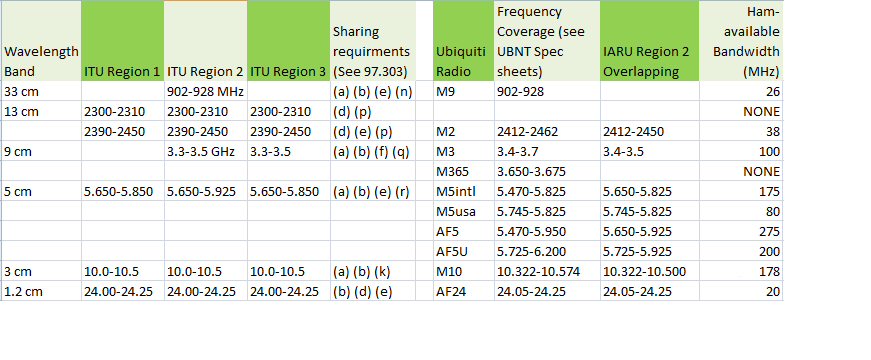
Enabling ham radio channels in wireless 802.11 devices
First off lets keep in mind that only Atheros chipset devices are capable of out of part 15 band operation.
The extreme range mini PCI Ubiquiti modules are meant to be used with a router board / station. (MikroTik networking equipment works similarly.) These boards have multiple slots to support multiple radio modules. For instance you could have a 900 MHz user LAN module and a 5.8 GHz backbone module. The router station comes preloaded with Open-WRT Standard. Open WRT is a Linux-based firmware program that primarily uses a command-line interface, but also features an optional web-based GUI interface. The Open WRT distribution has all the necessary drivers to see the radio modules and network routing and madwifi radio drivers. Optionally you can load something like DD-WRT if you are more familiar with that.
To enable the ham radio channels on these mini PCI devices you can do this from the linux command line if you are using Open WRT. It's very easy, all you do is edit the /etc/modules.d/50-madwifi to include the countrycode parameter, use country code XX to enable without regulatory constraints.
Embedded Atheros radio devices such as La Fonera, D-Link DIR-300 home grade as well as Ubiquit Nanostaiton, and Bullet professional grade products all have firmware running onboard Flash ram to control the radio chipset. All you do is go into the graphical user interface with your web browser and change the country code (or enable the super channel for DD-WRT). (With home grade Atheros routers such as the La Fonera, D-Link DIR-300, you will likely need to load third party firmware such as DD-WRT to be able to enable out of band opperation. This is done via the web based firmware update box or using TFTP)
Once you have done this a new channels list will be available. 2312-2484 MHz for 802.11g devices and 5660-5925 MHz for 802.11a devices. Expanded channel lists for proprietary radio modules such as the 900 MHz and 3 GHz devices work similarly. They simply have integrated tranverters using a local oscillator that shift the frequency from the base 802.11g or a chipset.
DD-WRT screenshot: http://www.qsl.net/kb9mwr/projects/wireless/ddwrt-ham.jpg
AirOS screenshot: http://www.qsl.net/kb9mwr/projects/wireless/airos-ham.jpg
References and more information on Atheros, Ubiquiti and more: http://www.qsl.net/kb9mwr/projects/wireless/modify.html
Amateur Radio Allocations and Overlapping Part 15 Bands - An Overview And a Part 97 versus Part 15 and Permissible Power Comparison http://www.qsl.net/kb9mwr/projects/wireless/allocations.htm This shows the feasible channel selection overlay. The channels in light blue fall into overlapping amateur band space. And are acceptable for HSMM operation.
Also refer to this Ubiquiti Product/Model overlapping coverage compatibility chart:

The Atheros Chipset allows you to to reduce your channel width. The default 802.11 channel is 20 MHz wide and yields speeds up to 54 MB. You can reduce the channel with to half it's size and still have about 24 Mbps or a quarter size, a 5 MHz wide channel yielding about 10 Mbps.
This channel size reduction lets you fit in channels in the lower part of the 2.3 GHz amateur band, and other places. Some other advantages are that enables you to go placed with lower noise floors.
As you can see you can squeeze seven 5 MHz wide channels below the first Part 15 channel on 2.4 GHz, two of which are completely outside of the Part 15 overlap. (Thus, should have quieter noise floors) On the 5 GHz band, there are thirteen channels that are completely outside of the Part 15 overlap.
Configuring station identification.
Early microwave data pioneers such as Glen, N6GN, Barry, VE3JF and John KE5FX employed MAC (machine access control) based identification. At the time this involved custom burring a MAC address translating to ones callsign using the ASCII code to an EEPROM. Fortunately now days we have softmacs, so changing a MAC address can be done on the fly much easier. Many embedded access point devices have an option for MAC cloning which will allow you to change it. To change your devices MAC address, you specify your callsign in hex. For Linux systems 'ifconfig eth1 hw ether 4B:42:39:4D:57:52' will do the trick. Working your callsign in at a MAC layer does seem the best, as it ensures it is always transmitted. Simply pad any unused fields with spaces (hex 20) if you have a short callsign. You can use lower and upper case in the event there are multiple devices on your network that use the same callsign.
AirOS appears to lack the ability to manipulate the MAC using the web GUI. Where DD-WRT does allow a MAC address cloning ability by using the GUI. You can always telnet or SSH into the device and change it using the ifconfig command.
If you get the error - SIOCSIFHWADDR: Device or resource busy, when trying to change the MAC address, try:
ifconfig eth0 down hw ether 4B:42:39:4D:57:52; ifconfig eth0 up Optionally you can edit /etc/sysinit/netconfig.conf
References and more information: http://www.qsl.net/kb9mwr/projects/wireless/pingid.html
Video Overview of this document: http://www.youtube.com/watch?v=XXptUTUCwAM